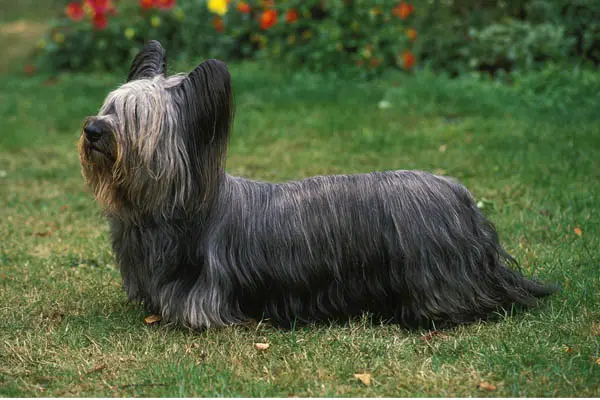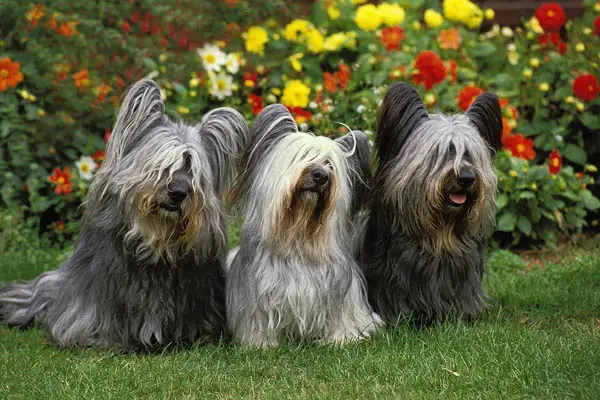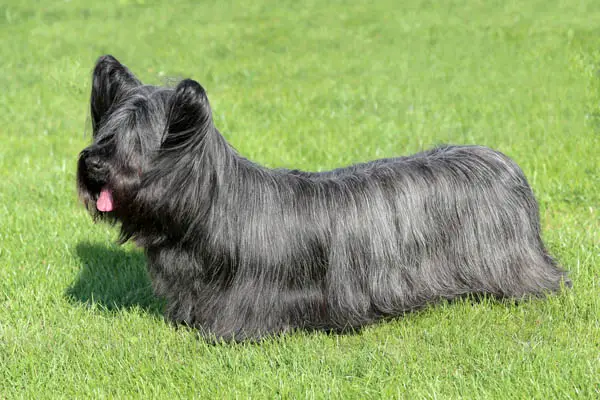Skye Terriers are medium-sized dogs that stand at a height of 10 inches. The Skye Terrier is known for its distinctive looks that feature long, flat-lying coats and a hairdo that almost covers their eyes. They come in two varieties: the prick-ear that points upward, and the drop-ear that are larger, lower, and points downward.
The hair on these dogs’ heads commonly covers their whole face and ears. They also come in a range of colors – black to platinum. Some are also fawn or cream-colored with the ears, muzzles, and tails usually darker than the rest of their bodies.
Skye Terriers are often described as big small dogs. They are fearless dogs, but affectionate when it comes to their families. They expect you to return the same amount of affection and attention. And if you do, expect that they will make you laugh, brightening your day every day.

Skye Terrier Statistics
| Dog Breed Group | Terrier |
| Breed Size | Medium |
| Height | 10 inches (male); 9.5 inches (female) |
| Weight | 35-45 pounds (male); slightly lighter (female) |
| Lifespan | 12-14 years |
Skye Terrier Ratings
| Energy level | |
| Exercise needs | |
| Requires attention | |
| Playfulness | |
| Trainability | |
| Shedding | |
| Grooming | |
| Friendly with family | |
| Friendly with kids | |
| Friendly with strangers | |
| Friendly with other dogs | |
| Prey Drive |
Skye Terrier History
The Skye Terrier is an old breed that originated from the Isle of Skye in Scotland more than four centuries ago. They were originally bred by farmers as working dogs and mainly used to hunt badgers, foxes, otters, and vermin.
There’s no record as to what dogs were involved in creating the breed. But one theory says that they came from Maltese dogs that survived a Spanish shipwreck near the island. These dogs were then crossed with local terriers, thus producing the breed.
Although they’ve been established for years, Skye Terriers have been known for many names. By the 1800s, the breed became one of the favorites of Queen Victoria, and they became one of the most popular terrier breeds among British aristocrats.
The American Kennel Club recognized the Skye Terriers in 1887, and the Skye Terrier Club of America was founded in 1938.
Skye Terriers currently ranks 178th as the most popular dog breed in the US. Though the dogs have great personalities, they are still considered a rare breed.

Skye Terrier Temperament
Skye Terriers are courageous, good-tempered, and canny dogs. They are more serious and dignified than most terriers, with a few known to be laid-back when indoors.
They are not very active dogs and would be contented by being taken out for walks or play sessions in the backyard. However, take note that these are hunting dogs, so they have strong hunting instincts. Make sure that you keep them on a leash or that your backyard is securely-fenced.
These dogs are loyal and affectionate to family, even with children. They thrive for companionship and attention, so they should not be ignored. They will not be the best pets for those who regularly go out of the house for long periods.
Skye Terriers are known to be cautious with strangers, and they may act dominant with other dogs. They will not be the best dogs for those who own smaller pets as they might chase them down.
Socialization is essential for these dogs. This will help make them more well-rounded and get them accustomed to new people and situations, so they know how to handle their feelings.
In training, make sure that you are firm and consistent. If these dogs feel you don’t have the confidence, they will try to dominate you to get what they want.
Never handle them harshly. These dogs are sensitive and have a long memory. They won’t appreciate you being heavy-handed. Shower them with positive reinforcements, instead, to improve the relationship between both of you.
Skye Terrier Care Requirements
- Nutrition: Skye Terriers don’t have special dietary requirements, but it’s essential that you only feed them high-quality and well-balanced meals. You should also be careful of the number of calories you fed them every day as they might get overweight. For home-cooked meals, it’s crucial that you only buy high-quality ingredients. Find the best sources of proteins, fats, carbohydrates, vitamins, and minerals, as these are the essential nutrients for your dog’s growth. We highly recommend adding fruits and vegetables as these are excellent sources of fiber. Take note if your dog is allergic to anything, and make sure to stay away from those. If you plan to give dog food, check the ingredients, and make sure that it doesn’t contain fillers, additives, and by-products. These have low nutritional value and might only cause problems for your dog’s digestion. If you’re unsure, ask your vet for advice. He’ll be able to come up with a feeding guide that is specific to your dog’s needs.
- Grooming: Skye Terriers have medium-length double coats that shed seasonally. It might look hard to maintain, but all it needs is frequent or daily brushing. Brushing will help remove debris and loose hair and prevents mats and tangles from forming as well. It ensures that your dog will always look his best. The coat must always keep its natural state, so no trimming is required. Baths should be given occasionally, depending on how much your dog needs it. Some owners do it once a month. And remember, there’s no need to scrub the coat when shampooing as this might only cause mats to form. Ears should be cleaned regularly to prevent ear infection. Check the nails frequently too, and make sure to trim it if it gets too long.
- Exercise: Skye Terriers are not very active dogs, but they need minimal exercise to remain healthy and happy. Usually, they just go along based on the level of activity their owners are comfortable with. Try to take him out for a few minute walk or play sessions to exercise his mind and body. You can also participate in canine sport so your dog can also showcase his skills.
- Health: Skye Terriers are generally healthy dogs, and there are not many diseases that you need to be worried about. If there’s one thing to remember, these dogs have achondroplasia, so they might suffer from disc injuries if allowed to go up and down the stairs. You should also monitor potential signs of cancer, autoimmune diseases, skin allergies, hip dysplasia, and patellar luxation. It’s essential to give your dog the right care so they grow up healthy. You can also meet at least one of your dog’s parents to be aware of any hereditary diseases your dog might acquire. We also advise closely monitoring your dog’s behavior. If you notice any changes, take him immediately to the vet.
- Lifespan: The life expectancy of Skye Terriers is 12-14 years.

Famous Skye Terriers
- Bobby: A Skye Terrier known to have stayed by his owner’s grave for 14 years until he died; Scotland’s most devoted dog in history.
- Romach: The first Skye Terrier registered by the American Kennel Club
- Charlie: A Skye Terrier who won Best in Show at the Eukanuba National Championship
Fun Facts about Skye Terriers
- Skye Terriers originated from the Isle of Skye, hence the name.
- They are called by many other names: Clydesdale Terrier, the Fancy Skye Terrier, the Silky Skye Terrier, the Glasgow Terrier, and the Paisley Terrier.
- They were originally bred by farmers to ward off pests.
- They are among the oldest of the terrier breeds.
- They are muses of Sir Edwin Landseer (painter and sculptor).
- They are endangered.
- They come in two varieties: drop-eared and prick-eared.
- They were recognized by the American Kennel Club in 1887.
Check Out Other Terrier Dog Breeds:
Airedale Terrier, American Hairless Terrier, American Staffordshire Terrier, Australian Terrier, Bedlington Terrier, Border Terrier, Bull Terrier, Cairn Terrier, Cesky Terrier, Dandie Dinmont Terriers, Glen of Imaal Terriers, Irish Terrier, Kerry Blue Terrier, Lakeland Terrier, Manchester Terrier, Miniature Bull Terrier, Miniature Schnauzer, Norfolk Terrier, Norwich Terrier, Parson Russell Terrier, Rat Terrier, Russell Terrier, Scottish Terrier, Sealyham Terriers, Smooth Fox Terrier, Soft Coated Wheaten Terrier, Staffordshire Bull Terrier, Welsh Terrier, West Highland White Terrier, Wire Fox Terrier
